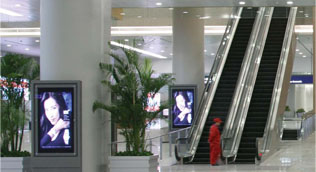Top-Flight Signage

- C-nario Digital Signage Platform Provides Multi-Screen Backbone For Two Shanghai Airports
- Ask any industry watcher in Asia which sector they see as being most critical to the growth of digital signage in the near future, and chances are their reply will be transportation. As some of the region’s fastest-growing economies pledge record amounts to invest in infrastructure, airports, train stations, and other passenger terminals are providing a rich and growing source of revenue to integrators with a competency in signage.
- Two of Shanghai’s airports, Pudong and Hongqiao, are a case in point, with both having just benefited from digital signage software solutions provided by C-nario. The Israeli-based manufacturer, through its Singapore office, was selected by JCDecaux Momentum Shanghai Airport Advertising Company as the technological platform provider and as the project’s prime contractor, following a rigorous evaluation process, which included reviewing solutions from several digital signage companies.
- Following the installations, Cnario’s Messenger and Universal Player solutions now manage an array of more than 200 displays in both airports. DVI Solutions, a Singapore- based company specializing in audio-visual solutions, services and installations,
The C-nario solution includes interactive screens, the content of which changes as passengers move past them. with offices in Shanghai, was the local subcontractor.
C-nario provided its player systems (hardware and software) to deliver 250 concurrent targeted and synchronized content channels to any number, size, resolution, or arrangement of screens in both airports. Displays include MUPI advertising panels, videowalls (including a huge 64-screen videowall), and TV screens. MUPI, an acronym for the French term Mobilier Urbain Pour Information (Urban Furniture for Information), is a type of sign about two square meters in size. The digital MUPI installed in Shanghai airports was designed by architect Jean- Michel Wilmotte for JCDecaux.
Content displayed in both airports includes advertising, announcements from the airport authority, and live TV—all in the highest pixel resolution. Some of the MUPI signs are arranged in groups, displaying the same information in a synchronized playback, allowing objects to move from screen to screen, as people move by the screens. C-nario’s platform enables advertisers to upload and approve ads via the web.
C-nario’s open architecture and smart plug-ins provide good integration with the workflows and processes of JCDecaux Momentum Shanghai Airport Advertising Company, without code modification. Implementation was carried out in a record time of two months, and included adapting C-nario’s players to the unique structure and arrangement of the various screens, including the ability to withstand the thermal load of various display systems.
“C-nario’s software is an excellent and scalable platform that perfectly meets the outdoor and indoor advertising needs at Shanghai’s airports,” comments Thierry Bardoux, General Manager, JCDecaux Momentum Shanghai Airport Advertising Company. “C-nario’s ability to produce perfect output has met our requirements. Advertisers are highly impressed by the overwhelming impact that the displays have on passengers, as well as by the competitive size of the project, the high-definition visual performance, the exclusive location, and the persuasive network.”
A daily selection of the top stories for AV integrators, resellers and consultants. Sign up below.
The AVNetwork staff are storytellers focused on the professional audiovisual and technology industry. Their mission is to keep readers up-to-date on the latest AV/IT industry and product news, emerging trends, and inspiring installations.
